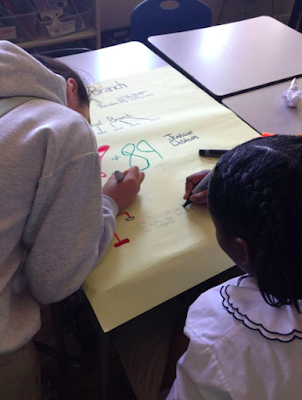I'm one of those people that likes anchor charts more in theory than in practice. Anchor charts can be great! They can be a visual way for students to refer to new vocabulary, concepts, or information during class time. They can also over-take the classroom. Students that struggle with organization and reading might be unintentionally left out of this support. If a student is unable to locate the poster or read it, it no longer becomes a meaningful resource. I am still working on a solution for using anchor charts in an organized manner. I don't yet have one (but let me know if you do... email me). However, I do have an answer for how to make anchor charts that allow all students to have access. Let's do it, interactive anchor charts!
Suggestion 1: Have students work in groups to create the anchor charts. Make sure to have students draft their ideas on a piece of scratch paper and that a teacher okays them before they create an anchor chart. All information on the anchor chart should be clear and correct. I like doing this in heterogeneous partnerships or small groups.
 |
| This partnership was working on creating a visual anchor chart to represent the Judicial Branch. Below is the finished product. |
|
 |
| Students used the anchor charts as a jigsaw activity and explained the information on the chart to their classmates. |
Suggestion 2: Ms. Shultz's patented Anchor Chart Scramble. In this activity, she wrote down an attribute that could be found in one of the three branches. Students had to find the anchor chart on the branch that included that attribute. For example, when Ms. Shultz wrote, "Congress" students scrambled over to the anchor chart that read Legislative Branch. This is a clever way for all students to interact with the anchor charts. This allows them to become more familiar with the charts and the information included on them.
 |
| Here's the wonderful Ms. Shultz holding up an attribute of the Legislative Branch for the Anchor Chart Scramble. |
Suggestion 3: Have an anchor chart scavenger hunt! This is a great way for students to familiarize themselves with the different posters around the room. This can be done individually or in small groups. I don't usually do this for a grade but instead have students work on the scavenger hunt until all of their answers are correct. When they are correct, they earn a small prize such as an eraser or fruit snacks.
 |
| Here is a page from a reading scavenger hunt that we made a few years back. |







Comments
Post a Comment